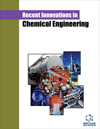- Home
- A-Z Publications
- Recent Innovations in Chemical Engineering (Formerly Recent Patents on Chemical Engineering)
- Previous Issues
- Volume 15, Issue 1, 2022
Recent Innovations in Chemical Engineering (Formerly Recent Patents on Chemical Engineering) - Volume 15, Issue 1, 2022
Volume 15, Issue 1, 2022
-
-
Personalized Nanotools for the Treatment of Metabolic Disorders
More LessAuthors: Arun Radhakrishnan, Gowthamarajan Kuppusamy and Thirumalai SubramaniamAdvances in personalized medicine are useful in improving the treatment of metabolic diseases and patient care. The current innovations in integrating nanotechnology and nanobiotechnology tools in pharmaceutical formulation development have proven the effectiveness of xenobiotics in diagnosing, treating, and curing various metabolic diseases. The implementation of nanomedicines for the treatment of metabolic dis Read More
-
-
-
New Efficient Configurations for Sour Wastewater Treatment
More LessAuthors: Mamdouh A. Gadalla, Ayat Ghallab, Ahmed M. Mansour, Fatma H. Ashour and Hany A. ElazabIntroduction: The environmental legislation on pollutant concentrations in aqueous effluents tends to tighten and increase due to the huge efforts devoted as a response to global warming and its related negative impact on our planet. As a result, sour water must be handled and processed properly to provide a high quality of stripped water with insignificant traces of NH3 and H2S. This approach must be achieved within the Read More
-
-
-
Production of Urea/Acetylated-lignin Sulfonate Matrix as SRFs and an Investigation on the Effect of Hydrodynamic Conditions on Release Rate Using the Biot Number
More LessAuthors: Samira Moradi, Keivan Shayesteh and Qasem MohammadzadehIntroduction: This study aimed to investigate the effect of hydrodynamic conditions on the release rate of urea/acetylated lignin sulfonate (Ac-LS) matrix as slow-release fertilizers (SRFs). Therefore, two models were developed using the mass transfer balance for the determination of finite/infinite volume of fluids and solving finite integral transformation/separation of a variable. The Biot number, validating the hydrody Read More
-
-
-
Degradation of Oxirane Ring for Epoxidation of Palm Oleic Acid via In Situ Performic Acid
More LessAuthors: Intan S. Azmi, Nurul Fathia Wahi and Mohd Jumain JalilBackground: The world’s raw material consumption has shifted from the use nonrenewable materials to renewable materials. Methods: In this study, the epoxidation of palm oleic acid was carried out by in situ performic acid to produce epoxidized palm oleic acid. Since the epoxide ring is highly reactive, the degradation of the oxirane was examined by using hydrogen peroxide, formic acid, and water. Results: A mathemati Read More
-
-
-
Application of Epoxy Resin for Improvement of the Banana Stem- Acoustic Panel
More LessBackground: Greener epoxidation by using vegetable oil to create an ecofriendly epoxide is being studied because it is a more cost-effective and environmentally friendly commodity that is safer than non-renewable materials. The aim of this research is to come up with low-cost solutions for banana trunk acoustic panels with kinetic modelling of epoxy-based palm oil. Methods: In this study, the epoxidation of palm oleic acid w Read More
-
-
-
Diffusion and Surface Reaction in Porous Cubical Catalyst: A Mathematical Approach
More LessAuthors: Sourav Ghosh and Dipankar PalBackground: Catalysts are the most vital part of any chemical industry. Catalyst is a substance that affects the rate of reaction, but the catalyst itself does not take part in the reaction. Catalysts offer different pathways of reaction by diffusing the reactant inside it to provide a large surface area within a small volume, thus, lowering the activation energy of molecules for reaction. Most of the catalytic reactions take place in a Read More
-
Most Read This Month
Article
content/journals/rice
Journal
10
5
false
en


